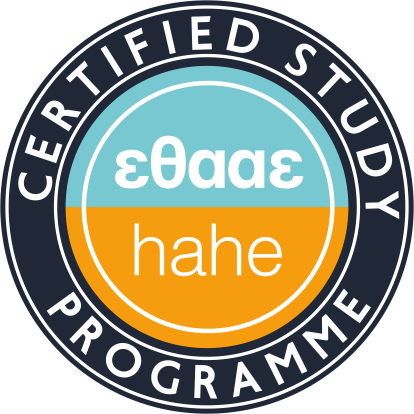General Linguistics and Translation ΙΙ
Teaching Staff: Tsigou Maria
Course Code: YK-6100
Gram-Web Code: ΓΛ1002-1
Course Category: Specific Background
Course Type: Compulsory
Course Level: Undergraduate
Course Language: Greek
Semester: 6th
ECTS: 2
Total Hours: 2
Erasmus: Not Available
The module attempts a closer analysis of topics such as the semantic units and their relations to each language, the ways different languages express the same experience differently, etc. Each of the major Grammatical Theories are outlined, while special emphasis is placed on Functional Grammar developed by A. Martinet and the Systemic Functional Grammar developed by MAK Halliday. Students are introduced to the concept of the Translation Unit and they investigate its effectiveness in the Didactics of Translation. The influence of context on language used is discussed, while a detailed analysis of language varieties is attempted with a focus on dialects and registers in students’ assignments.
Upon successful completion of the course, the students will be able to:
- To learn how translation process as intercultural communication works
- To recognize the value of language differentiation
- To use of translation techniques in order to translate
- To develop critical thinking
- To build automations for the confrontation of translation difficulties that emerge during interlingual translation process
Week 1:
The contribution of Linguistics to the Didactics of Translation. Critical approaches.
Week 2:
The contribution of Contrastive Linguistics to the Didactics of Translation. Translation techniques. Examples and exercises.
Week 3:
Linguistic analysis for the comprehension and transfer of morpho-syntactic, lexical, stylistic and pragmatic elements of the source language to the target language.
Week 4:
Martinet’s Functional Theory. Basic principles and critical approach.
Week 5:
Martinet’s Functional Theory as a theoretical framework for the analysis of language at sentence level. Analysis of examples from the Greek language.
Week 6:
The translation unit. Theoretical and critical approaches. Application on parallel texts of English-Greek language combination.
Week 7:
Halliday’s Systemic Functional Grammar. Basic principles and critical approach.
Week 8:
Halliday’s Systemic Functional Grammar as a theoretical framework for the analysis of language at text level. Emphasis on cohesion. Analysis of examples from the Greek language.
Week 9:
The significance of context and co-text in language. Context features. Examples and exercises.
Week 10:
Linguistic variety based on the user. Types of dialect. The example of the Greek language.
Week 11:
Linguistic variety based on the user. Emphasis on the relationship of registers and context. Examples and exercises.
Week 12:
Translation techniques for transferring the linguistic variety from one language (language A) to the other (language B). Exercises comparing the original and the translation and translation exercises.
Week 13:
Discussion on the translation exercises. Course recap and review of the primary parts of the learning material
Halliday M.A.K. & Hasan R. (1980) Cohesion in English London & New York: Longman.
Vinay J.P. & Dalbernet J. (1958/1977) Stylistique comparée du français et de l’anglais. Paris, Didier.
Γούτσος Δ. (2012) Γλώσσα: κείμενο, ποικιλία, σύστημα. Αθήνα: Κριτική.
Κλαίρης, Χ. (2007), Λειτουργική Γλωσσολογία, Μτφ. Ε. Σελλά-Μάζη, Αθήνα: Ελληνικά Γράμματα.
Μπαμπινιώτης Γ. (1980) Θεωρητική Γλωσσολογία Αθήνα: Ιδιωτική έκδοση.
Σελλά, Ε. και Μπατσαλιά, Φ. (2010), Γλωσσολογική προσέγγιση στη Θεωρία και τη Διδακτική της Μετάφρασης, Αθήνα: Παπαζήσης.
Τσίγκου (2014) «Η τύχη της γλωσσικής ποικιλίας ως φορέα πολιτισμού στη μετάφραση». Πρακτικά της 4ης Συνάντησης Ελληνόφωνων Μεταφρασεολόγων, 23-25 Μαΐου 2013 – Θεσσαλονίκη.
Τσίγκου Μ. (2010) «Σύντομη εισαγωγή στις σχέσεις γλωσσολογίας και μετάφρασης (με παραδείγματα από το ζεύγος Γαλλικής-Ελληνικής)» in Dictio 3, Επιστημονική Επετηρίδα – Υearbook 2008-2009. Κέρκυρα: Ιόνιο Πανεπιστήμιο, Τμήμα Ξένων Γλωσσών Μετάφρασης και Διερμηνείας. 225-250.
Τσίγκου Μ. (2011) Γλωσσολογία και Μετάφραση: Προσεγγίζοντας τη Μεταφραστική Μονάδα. Αθήνα: Δίαυλος.
Face to face teaching. The course’s duration is two hours by lecture delivered with the help of PowerPoint presentations and internet material. Exercises for understanding and applying the theoretical knowledge are regularly handed out to the students with selected examples from different languages, and they are considered an integral part of the learning process.
Use of ICT in teaching.
The students are assessed based on their participation in the teaching process throughout the term and their performance during the relevant exercises. The final assessment and grading of the course will be held through a written examination or a final dissertation.
Back
Undergraduate
Secretariat
Galinos Building (1st floor)
Corfu, GR-49132
Open to the public:
Mon, Wed, Fri: 11am - 1pm
Tue, Thu: 11am - 1pm (Erasmus+)
 E-Class Platform
E-Class Platform
 eSecretariat
eSecretariat
 Webmail
Webmail
 Learning Material Management
Learning Material Management
 Internship Portal
Internship Portal
 Library
Library





 General Linguistics and Translation ΙΙ
General Linguistics and Translation ΙΙ
